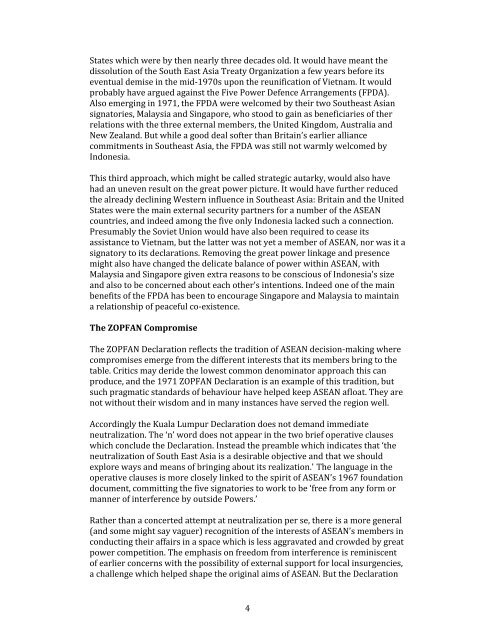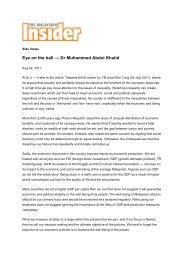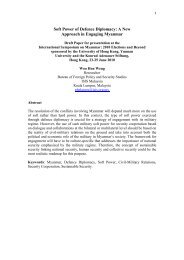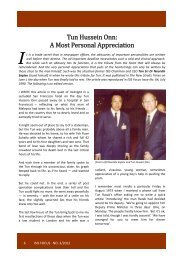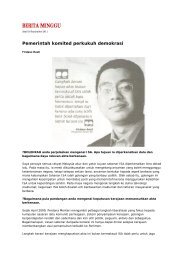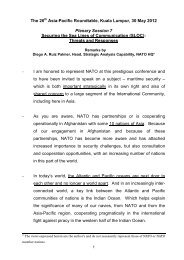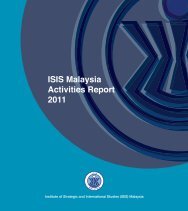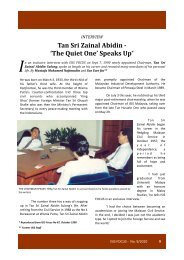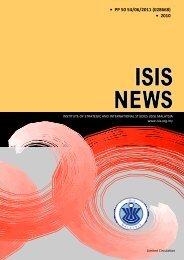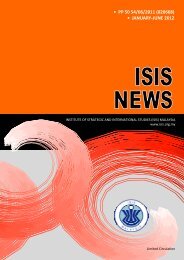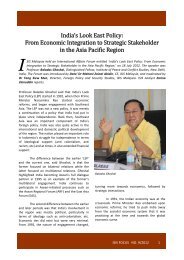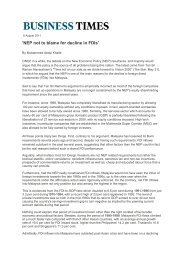ZOPFAN - ISIS Malaysia
ZOPFAN - ISIS Malaysia
ZOPFAN - ISIS Malaysia
Create successful ePaper yourself
Turn your PDF publications into a flip-book with our unique Google optimized e-Paper software.
States which were by then nearly three decades old. It would have meant the<br />
dissolution of the South East Asia Treaty Organization a few years before its<br />
eventual demise in the mid‐1970s upon the reunification of Vietnam. It would<br />
probably have argued against the Five Power Defence Arrangements (FPDA).<br />
Also emerging in 1971, the FPDA were welcomed by their two Southeast Asian<br />
signatories, <strong>Malaysia</strong> and Singapore, who stood to gain as beneficiaries of ther<br />
relations with the three external members, the United Kingdom, Australia and<br />
New Zealand. But while a good deal softer than Britain’s earlier alliance<br />
commitments in Southeast Asia, the FPDA was still not warmly welcomed by<br />
Indonesia.<br />
This third approach, which might be called strategic autarky, would also have<br />
had an uneven result on the great power picture. It would have further reduced<br />
the already declining Western influence in Southeast Asia: Britain and the United<br />
States were the main external security partners for a number of the ASEAN<br />
countries, and indeed among the five only Indonesia lacked such a connection.<br />
Presumably the Soviet Union would have also been required to cease its<br />
assistance to Vietnam, but the latter was not yet a member of ASEAN, nor was it a<br />
signatory to its declarations. Removing the great power linkage and presence<br />
might also have changed the delicate balance of power within ASEAN, with<br />
<strong>Malaysia</strong> and Singapore given extra reasons to be conscious of Indonesia’s size<br />
and also to be concerned about each other’s intentions. Indeed one of the main<br />
benefits of the FPDA has been to encourage Singapore and <strong>Malaysia</strong> to maintain<br />
a relationship of peaceful co‐existence.<br />
The <strong>ZOPFAN</strong> Compromise<br />
The <strong>ZOPFAN</strong> Declaration reflects the tradition of ASEAN decision‐making where<br />
compromises emerge from the different interests that its members bring to the<br />
table. Critics may deride the lowest common denominator approach this can<br />
produce, and the 1971 <strong>ZOPFAN</strong> Declaration is an example of this tradition, but<br />
such pragmatic standards of behaviour have helped keep ASEAN afloat. They are<br />
not without their wisdom and in many instances have served the region well.<br />
Accordingly the Kuala Lumpur Declaration does not demand immediate<br />
neutralization. The ‘n’ word does not appear in the two brief operative clauses<br />
which conclude the Declaration. Instead the preamble which indicates that ‘the<br />
neutralization of South East Asia is a desirable objective and that we should<br />
explore ways and means of bringing about its realization.’ The language in the<br />
operative clauses is more closely linked to the spirit of ASEAN’s 1967 foundation<br />
document, committing the five signatories to work to be ‘free from any form or<br />
manner of interference by outside Powers.’<br />
Rather than a concerted attempt at neutralization per se, there is a more general<br />
(and some might say vaguer) recognition of the interests of ASEAN’s members in<br />
conducting their affairs in a space which is less aggravated and crowded by great<br />
power competition. The emphasis on freedom from interference is reminiscent<br />
of earlier concerns with the possibility of external support for local insurgencies,<br />
a challenge which helped shape the original aims of ASEAN. But the Declaration<br />
4


